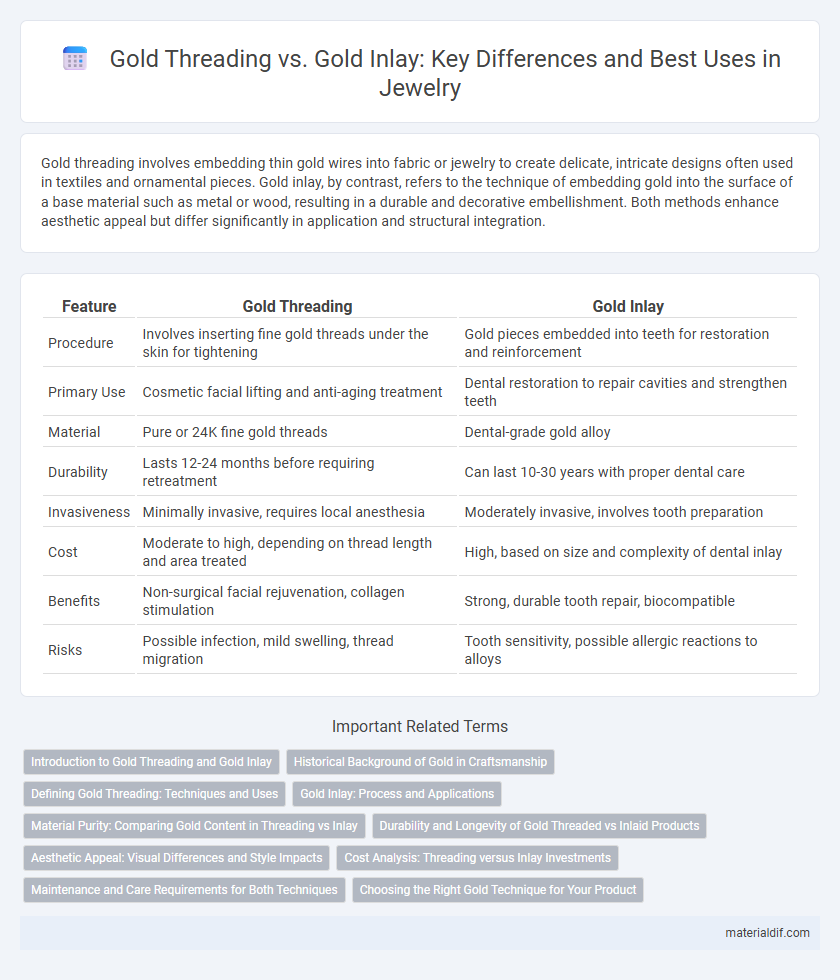Gold threading involves embedding thin gold wires into fabric or jewelry to create delicate, intricate designs often used in textiles and ornamental pieces. Gold inlay, by contrast, refers to the technique of embedding gold into the surface of a base material such as metal or wood, resulting in a durable and decorative embellishment. Both methods enhance aesthetic appeal but differ significantly in application and structural integration.
Table of Comparison
| Feature | Gold Threading | Gold Inlay |
|---|---|---|
| Procedure | Involves inserting fine gold threads under the skin for tightening | Gold pieces embedded into teeth for restoration and reinforcement |
| Primary Use | Cosmetic facial lifting and anti-aging treatment | Dental restoration to repair cavities and strengthen teeth |
| Material | Pure or 24K fine gold threads | Dental-grade gold alloy |
| Durability | Lasts 12-24 months before requiring retreatment | Can last 10-30 years with proper dental care |
| Invasiveness | Minimally invasive, requires local anesthesia | Moderately invasive, involves tooth preparation |
| Cost | Moderate to high, depending on thread length and area treated | High, based on size and complexity of dental inlay |
| Benefits | Non-surgical facial rejuvenation, collagen stimulation | Strong, durable tooth repair, biocompatible |
| Risks | Possible infection, mild swelling, thread migration | Tooth sensitivity, possible allergic reactions to alloys |
Introduction to Gold Threading and Gold Inlay
Gold threading involves weaving fine gold wires into fabric or materials to create intricate patterns, enhancing durability and aesthetic appeal with the natural luster of gold. Gold inlay is a decorative technique where gold is embedded into surfaces such as metal, wood, or stone, resulting in detailed designs that offer both ornamental and value-added qualities. Both methods highlight gold's malleability and resistance to tarnish, making them popular in luxury craftsmanship and heritage artwork.
Historical Background of Gold in Craftsmanship
Gold threading traces back to ancient Egyptian and Indian textile traditions where thin gold wires were woven into fabrics symbolizing wealth and divinity. Gold inlay, prominent in medieval Europe and East Asia, involved embedding gold into metal surfaces for ornamental weaponry and religious artifacts. Both techniques showcase gold's enduring role in enhancing artistic expression and cultural significance across civilizations.
Defining Gold Threading: Techniques and Uses
Gold threading involves the precise embedding of fine gold wires into gemstones or dental surfaces, enhancing both aesthetic appeal and structural reinforcement. This technique uses micro-filigree insertion or laser-guided threading to create intricate patterns or bolster durability, often favored in high-end jewelry and restorative dentistry. Its applications range from decorative enhancements in luxury accessories to functional improvements in dental restorations, distinguishing it from gold inlay processes that typically involve filling cavities or grooves with solid gold pieces.
Gold Inlay: Process and Applications
Gold inlay involves embedding precisely crafted gold pieces into cavities prepared within the tooth, ensuring a durable and biocompatible restoration with excellent aesthetics. The process requires meticulous impression taking, wax modeling, and casting of the gold alloy, followed by careful fitting and bonding within the tooth structure. Gold inlays are commonly used for restoring moderate tooth decay and fractures, offering superior longevity and resistance to wear compared to other dental materials.
Material Purity: Comparing Gold Content in Threading vs Inlay
Gold threading typically uses higher purity gold, often 22-24 karats, ensuring maximum gold content and enhanced biocompatibility. Gold inlays usually incorporate lower purity alloys, around 14-18 karats, to improve durability and resistance to wear while maintaining aesthetic appeal. The difference in gold content affects both the longevity and visual outcome of dental restorations, balancing purity with functional demands.
Durability and Longevity of Gold Threaded vs Inlaid Products
Gold threading offers superior durability due to its method of embedding thin gold wires into materials, resulting in enhanced resistance to wear and tear over time. In contrast, gold inlay involves embedding gold pieces into carved recesses, which can be more susceptible to loosening or damage under heavy use. The longevity of gold-threaded products typically exceeds that of gold-inlaid items, making threading a preferred choice for applications requiring sustained aesthetic integrity and structural resilience.
Aesthetic Appeal: Visual Differences and Style Impacts
Gold threading offers a subtle, intricate design that enhances fabric with fine metallic lines, creating a delicate shimmer ideal for elegant garments. Gold inlay presents a bolder aesthetic through solid gold accents embedded into jewelry or ornaments, providing a striking contrast and luxurious shine. The visual difference significantly impacts style choices, with threading favored for textiles needing refined detail and inlay suited for statement pieces demanding prominent gold features.
Cost Analysis: Threading versus Inlay Investments
Gold threading generally involves a lower initial investment compared to gold inlay due to its minimal material usage and simpler procedure. Gold inlay, requiring precise craftsmanship and more gold content, tends to incur higher costs but offers increased durability and aesthetic appeal. Evaluating long-term value versus upfront expense helps determine the most cost-effective choice for gold enhancements.
Maintenance and Care Requirements for Both Techniques
Gold threading requires regular polishing to maintain its shine and prevent tarnishing, as it is typically exposed on the surface of jewelry or fabric. Gold inlay, being embedded within a base material, demands careful cleaning with non-abrasive methods to avoid damaging the surrounding surface. Both techniques benefit from storage in a dry, soft-lined environment to minimize scratches and preserve the integrity of the gold.
Choosing the Right Gold Technique for Your Product
Gold threading offers intricate, delicate designs ideal for lightweight jewelry and fine embroidery, enhancing elegance without compromising flexibility. Gold inlay provides durability and a polished finish suitable for robust items like watches or decorative objects requiring long-lasting detail. Selecting the right gold technique depends on the product's function and aesthetic demands, balancing craftsmanship with material resilience.
Gold Threading vs Gold Inlay Infographic

 materialdif.com
materialdif.com